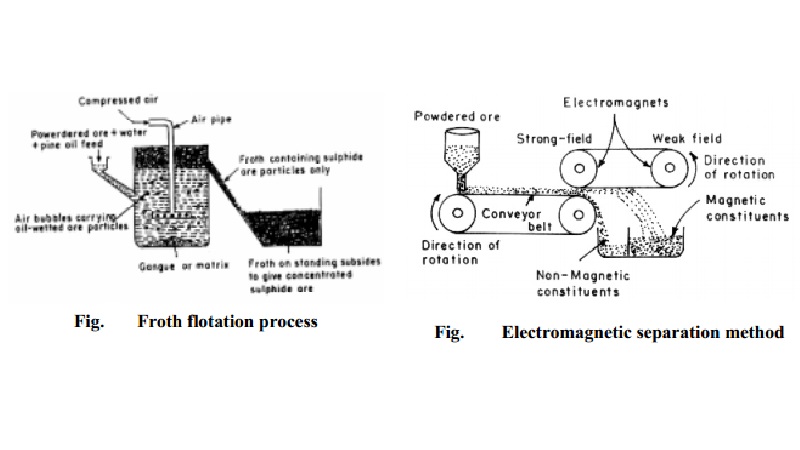Chapter: 11th 12th std standard Class Organic Inorganic Physical Chemistry Higher secondary school College Notes
Metallurgy - Purification of ores

Metallurgy - Purification of ores
The ore is generally associated with rock impurities like clay, sand
etc. called ' gangue or matrix'. The
purification of ore means removal of gangue from the powdered ore. This process
is otherwise called concentration of the ore or ore dressing. Thus, the
percentage of the ore in the concentrated ore is higher than that in the
original ore. The purification or concentration of ore can be brought about in
the following ways, depending upon the type of ore.
(i) Gravity
separation process or hydraulic
washing
This method is especially suitable for heavy 'oxide' ores like
haematite, tinstone, etc. In this, the powdered ore is placed on a sloping
floor (or platform) and washed by directing on it a strong current of water.
The lighter sandy, and earthy impurities are washed away; while the heavier ore
particles are left behind.
(ii) Froth flotation process
This method is especially suitable for sulphide ores like zinc blende
(ZnS), and copper pyrites (CuFeS2). This process is based on the
fact that the sulphide ore particles are only moistened by oil; while those of oxide, and gangue particles are moistened only
by water. In this process, the
powdered ore is mixed with water and a little pine oil (a foaming agent) and
the whole mixture is then stirred vigorously by blowing compressed air. The oil
forms a foam (or froth) with air. The ore particles stick to the froth, which
rises to the surface; while the rocky, and earthy impurities (gangue) are left
in water Fig.. The froth is skimmed
off, collected, and allowed to subside to get concentrated ore.
(iii) Electromagnetic separation process
This method is meant for separating magnetic
impurities from non-magnetic ore particles, e.g., tinstone (a tin ore) in
which tinstone is non- magnetic;
while impurities iron, manganese and tungstates are magnetic. The powdered ore
(containing the associated magnetic impurities) is made to fall (from a hopper)
on a belt moving over electromagnetic roller. The magnetic impurities fall from
the belt in a heap near the magnet, due to attraction; while the non-magnetic
concentrated ore falls in separate heap, away from the magnet, due to the
influence of centrifugal force Fig.
(iv) Chemical method
This method is employed in case where the ore is
to be in a very pureform, e.g., aluminium extraction. Bauxite (Al2O3),
an ore of aluminium, contains SiO2 and Fe2O3
as impurities. When bauxite ore is treated with NaOH, the Al2O3
goes into solution as sodium meta-aluminate leaving behind the undissolved
impurities [Fe2O3, SiO2, Fe(OH)3,etc.],
which are then filtered off.
Al2O3 + 2NaOH + 2NaAlO2 - - > H 2O
Sod. meta. aluminate (In solution form)
The filtrate (containing sodium meta-aluminate) on dilution, and
stirring gives a precipitate of aluminium hydroxide, which is filtered, and
ignited to get pure alumina.
NaAlO2
+ 2H 2O
- > Al(OH)3 (Ppt )+ NaOH
2Al(OH)3 -> on eq- > Al2O3(Pure
)+ 3H 2O
Related Topics